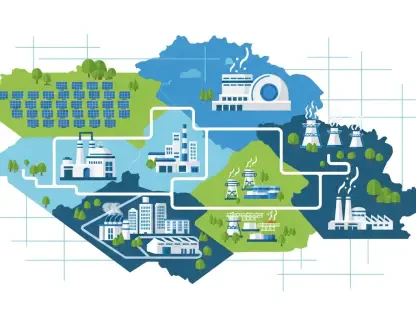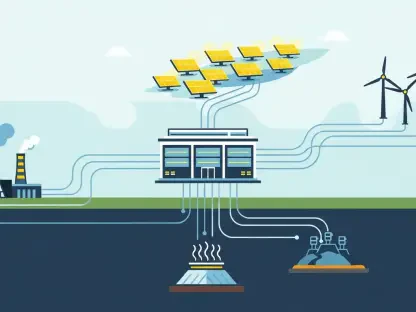In the quest for sustainable energy solutions, hydrogen co-firing turbines stand out as innovations with the potential to revolutionize the energy sector. This technology, which integrates hydrogen with traditional natural gas, represents a key advancement toward reducing carbon emissions and enhancing energy efficiency. This review delves into its development, features, and impact, providing a comprehensive overview of its role in modern energy landscapes.
Setting the Stage: The Emergence of Hydrogen Co-Firing Turbines
The emergence of hydrogen co-firing turbines marks a significant shift in energy technology, driven by the urgency to lower carbon footprints worldwide. These turbines operate by blending hydrogen with natural gas to be used as fuel for generating electricity. This approach not only reduces carbon dioxide emissions but also aligns with global sustainability goals. As energy demands rise, adopting cleaner technologies becomes crucial. In this context, the co-firing turbine holds a promising position within the broader effort to decarbonize energy production.
In the realm of technological advancement, hydrogen co-firing turbines have gained attention for their ability to incorporate renewable energy sources into traditional systems. The turbines’ design and operational mechanisms reflect cutting-edge engineering, facilitating their integration into existing infrastructure. This highlights the relevance and adaptability of hydrogen technology, reinforcing its importance as the energy sector evolves.
Unpacking the Technology: Key Features and Components
Pioneering Hydrogen Integration
At the heart of hydrogen co-firing turbines lies the innovative hydrogen blending technology. The core function of this feature is to efficiently combine hydrogen with natural gas, enabling the turbine to produce cleaner energy. This blending process is a critical component of the turbine’s functionality, as it directly influences performance metrics such as efficiency and emissions reduction. This pivotal technology demonstrates significant importance, serving as the primary driver behind the turbine’s environmental and operational benefits.
The introduction of hydrogen blending marks a transformational leap in turbine capabilities. It extends the applicability of these turbines beyond conventional energy sources, illustrating a shift toward embracing cleaner fuel alternatives. This strategic innovation signifies a commitment to reducing environmental impact while maintaining energy output, showcasing its technical sophistication and pivotal role within hydrogen co-firing systems.
Advanced Combustion Dynamics
Complementing hydrogen blending technology, advanced combustion systems play a crucial role in ensuring efficient energy production. These systems are engineered to handle the specific requirements of mixed-fuel combustion, optimizing the burning process to reduce emissions and enhance performance. By refining combustion techniques, these turbines achieve faster start-up times and greater operational flexibility, resulting in cost savings and improved energy management.
The real-world application of these combustion systems has proven beneficial, enabling turbines to operate under varied conditions while maintaining high efficiency. Their resilience and adaptability are further evidenced by their seamless integration into existing energy infrastructures. This technological maturity underscores their significance in driving forward the adoption of hydrogen-rich energy solutions in diverse settings.
Innovations and Trends in Hydrogen Co-Firing
Recent advancements in hydrogen co-firing technology have underscored its growing importance within the energy sector. The successful demonstration of hydrogen-blend trials, such as the one achieved at Georgia Power’s Plant McDonough-Atkinson, has set a precedent for future developments in this field. Achieving a 50% hydrogen blend marks the first occurrence of its kind in advanced-class gas turbines, reflecting a notable leap in technological progress and ambition.
This innovation has emerged during a period when the energy industry is keenly focused on carbon reduction and sustainability. Trends show a shift in both consumer and industry behavior towards cleaner energy solutions. Successful projects like this one highlight ongoing efforts to increase hydrogen utilization as a fuel, encouraging more stakeholders to invest significantly in research and development, promising continued advancements and adoption of hydrogen-fueled energy systems.
Real-World Applications and Impact
In practical applications, hydrogen co-firing turbines are making significant strides across various industries. Their primary deployment in power generation plants like those used by Georgia Power illustrates their potential to cater to extensive urban areas, supplying electricity to a significant number of households. The technology’s capacity to facilitate the transition from fossil fuels to cleaner alternatives underscores its role in driving forward sustainable practices.
Equally important are unique use cases demonstrating the versatility of hydrogen co-firing technology. Deployments in sectors such as manufacturing and refining showcase its adaptability and efficiency in diverse operating environments. These applications reinforce the broader influence of hydrogen co-firing turbines, highlighting their capability to transform industry standards and encourage cleaner, more efficient energy production.
Addressing the Challenges and Limitations
Despite promising advancements, hydrogen co-firing turbines face several challenges. Technical hurdles, particularly concerning hydrogen storage and supply, need addressing to ensure widespread adoption. Additionally, regulatory barriers and market resistance can impede the integration of hydrogen technologies into existing energy systems. Overcoming these obstacles requires concerted efforts by industry leaders and policymakers to create a supportive environment for hydrogen innovation.
Efforts to mitigate these challenges are evident through ongoing research and collaboration across sectors. By investing in infrastructure development and fostering supportive policies, the adoption of hydrogen co-firing technology can overcome existing barriers. Continued exploration of hybrid solutions and improved hydrogen handling techniques will play a pivotal role in addressing these limitations, paving the way for broader implementation.
Future Prospects and Developments
Looking ahead, hydrogen co-firing turbines show significant potential for future growth and breakthroughs. As technology evolves, the integration of more advanced hydrogen-gas mixes could further reduce emissions and enhance energy generation efficiency. The continuous push for innovation promises to unlock new capabilities, positioning hydrogen as a key component of a sustainable energy future.
In the long term, hydrogen co-firing technology could redefine energy production methods globally. Its role in the transition to low-carbon economies presents an exciting opportunity for environmental and economic benefits. Future trajectories suggest a steady increase in research focus and investment, with an emphasis on scalability and cost reduction to facilitate broader impact and acceptance.
Conclusion
In reviewing the developments and impacts of hydrogen co-firing turbines, it was clear that the technology presented a groundbreaking path for clean energy solutions. By blending hydrogen with natural gas, emissions were reduced significantly, offering a viable path toward achieving a low-carbon future. Innovations in blending and combustion technologies illustrated substantial progress, setting a strong foundation for continued development and application.
While challenges remained in terms of technical and regulatory barriers, efforts to overcome these limitations were ongoing and showed promise. The roadmap for hydrogen co-firing technology suggested a trajectory toward greater industry integration and global use, supported by breakthroughs and supportive policies. Reflecting upon these facets, the potential for hydrogen co-firing turbines to transform energy landscapes and contribute to sustainable development goals resonated as both significant and promising.









